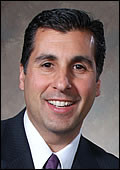Moore: Igliozzi Provides Fiscal Sanity, Leadership in Providence
Monday, October 17, 2016
By all accounts, the City of Providence is in a precarious financial position.
There are countless instances of finance professionals talking about the prospect of bankruptcy being the only realistic way for the financially mismanaged city to find its way back to prosperity once again.
Most recently, and perhaps most notably, former Cranston Mayor and finance professional Steve Laffey, wrote in GoLocalProv.com just a few weeks ago wrote a column arguing that very point.
GET THE LATEST BREAKING NEWS HERE -- SIGN UP FOR GOLOCAL FREE DAILY EBLAST“If Providence has a $1.8 billion problem, and 60,000 households then that’s $30,000 per household - about 3 times the magnitude of California!! Hello, anyone listening! And California has the same advantages of a state over a medium sized city. Case closed,” Laffey wrote.
There are few folks I respect more than the former Cranston Mayor, particularly when it comes to the issue of municipal finance. Therefore, his remarks make me lean towards the camp that believes declaring bankruptcy may very well be the best path forward.
Time is Running Out
Yet if city leaders are hell-bent on avoiding receivership and the mess that would entail, it’s imperative that they make prudent financial decisions. You’d think that goes without saying. When you’re in a hole, you should stop digging, and all that.
Recent actions by the administration would make one think that the city is on perfectly solid financial footing.
The administration touted a new contract aimed at settling the city’s longstanding dispute with its firefighters over the administration’s move to force the firefighters to work on a three shift schedule that took place in the summer of 2015. The administration has agreed to move back to the traditional four shift schedule in exchange for a reduction in minimum manning—from 94 to 88 firefighters per shift. The agreement also pays firefighters a raise of roughly 12.5 percent over a 5-year period—the life of the contract.
Apparently, the Jorge Elorza administration expected the city council to simply rubber stamp the agreement. The administration failed to send the council a detailed fiscal note, which would lay out, in a very detailed and intricate manner, where all the savings (or perhaps costs) would be realized.
Transparency?
Maybe they thought that the council planned on taking a page out of former Congressional House Speaker Nancy Pelosi who infamously once remarked “we need to pass the bill to find out what’s in it”, when talking about Obamacare.
Fortunately, John Igliozzi, the Providence City Council Finance Chairman, has other ideas. To his credit: Igliozzi has criticized the administration for failing to provide the details, where the devil often hides. Those details, explained in the fiscal note, are supposed to be provided to the council this week.
It’s a good thing that the council has demanded the information. To ratify the agreement without seeing the details would a gross dereliction of duty on their part. The city council is a co-equal branch of government within the city. It doesn’t always work like it is, but city residents are better served when it does.
What’s more, the council shouldn’t have to have demanded to the given the information. And once they demanded it, the city should have been readily able to produce it. The fact that they didn’t suggests that they didn’t really know exactly what they’re saving through this agreement. That’s frightening.
Solid Leadership From Igliozzi
Igliozzi is also correct to point out that the agreement should contain pension reforms that also save taxpayer dollars and strengthen the system for current and future retirees. As of now, the current agreement doesn’t take on pension reform.
Once all the information regarding the savings contained within the contract becomes available, the city council will be able to clearly decide whether the deal is truly in the best interests of the city’s beleaguered taxpayers.
The city cannot afford to affirm collective bargaining agreements merely because it will appease a union or the administration. The days of doing convenient things that we cannot afford are over—unless the city wants to find itself in bankruptcy. Then again, maybe that’s not such a bad thing.
Russell J. Moore has worked on both sides of the desk in the Rhode Island media, both for newspapers and on political campaigns. Send him email at [email protected]. Follow him on twitter @russmoore713.
Related Slideshow: Providence Pension Liability
A new report shows that Providence’s pension fund—even after the recent reform—is still in trouble. The below slides break out the key numbers for the pension fund, including the unfunded liability, the assumed and actual rates of return, the current level of benefits, and how long it will take the city to pay off the unfunded liability. Figures are current as of July 1, 2013 and are taken from the new Jan. 31 actuarial report from Segal Consulting.
Related Articles
- Moore: RI Reformers Winning Big This Year
- Moore: Cynicism Dominates RI Politics
- Moore: House Budget Punishes Charter School Success
- Moore: Voters Must Demand Transparency From ProvPort
- Moore: Raimondo Let Insider Politics Kill Bill to Protect Women
- Moore: A Bad News Week For RI Reformers
- Moore: The Real Ethics Reform Heroes Aren’t Legislative Leadership
- Moore: Elorza Releases Devastating Report; Is Anyone Listening?
- Moore: I Still Think Clinton Wins RI Tomorrow
- Moore: Elorza’s Budget Doesn’t Match His Rhetoric
- Moore: Federal Hill’s Parking Meter Lesson
- Moore: Happy Fourth, Now Remember It’s Meaning
- Moore: Shocking Police Beating Video Warrants Answers
- Moore: Will Mattiello Appease Progressives?
- Moore: Progressives Are Being Disingenuous
- Moore: Catholic Church Should Focus on Charity, Not Firing Gays
- Moore: Time to Overhaul the State Investment Commission
- Moore: A Mattiello Defeat May Be a Hollow Victory for GOP
- Moore: Apathy Portends Low Turnout This Primary Election
- Moore: Is Election 2016 the End of The Mainstream Media?
- Moore: RI Progressives “Major in the Minors”
- Moore: Will RI Government Rules Close a Key Nonprofit?
- Moore: Only Voters Can Stifle RI Corruption
- Moore: Raimondo’s Pension Fund Experiment Fails














2013.png)
.png)













2013_80_80_c1.png)
_80_80_c1.png)



